Professional Development: Knowledge Assessment on Disability Support
VerifiedAdded on 2023/04/20
|21
|3994
|267
Homework Assignment
AI Summary
This document presents a comprehensive solution to a knowledge assessment on disability support practices. It covers various aspects, including communication strategies for individuals with disabilities, appropriate terminology, and tools for skills development. The assignment explores positive behavior support, community inclusion, and empowering individuals with disabilities. It addresses legal and ethical considerations, such as codes of conduct, informed consent, and human rights. The solution provides examples of best practices, discusses the roles of carers and families, and examines the importance of recognizing learning opportunities. The assignment is divided into four parts: skills development using a strengths-based approach, person-centered behavior supports, community participation and social inclusion, and empowering people with disabilities, providing a holistic view of disability support.
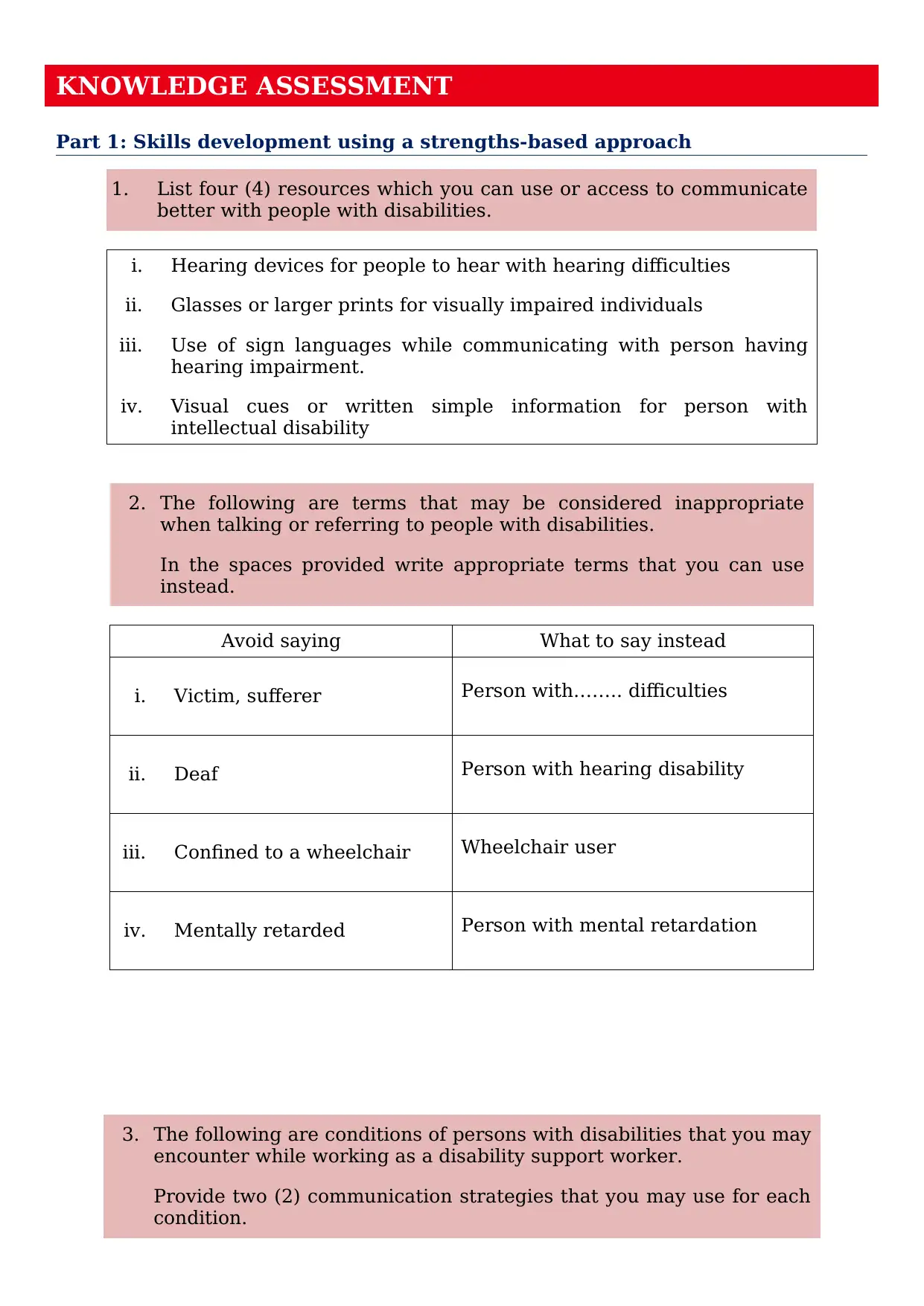
KNOWLEDGE ASSESSMENT
Part 1: Skills development using a strengths-based approach
1. List four (4) resources which you can use or access to communicate
better with people with disabilities.
i. Hearing devices for people to hear with hearing difficulties
ii. Glasses or larger prints for visually impaired individuals
iii. Use of sign languages while communicating with person having
hearing impairment.
iv. Visual cues or written simple information for person with
intellectual disability
2. The following are terms that may be considered inappropriate
when talking or referring to people with disabilities.
In the spaces provided write appropriate terms that you can use
instead.
Avoid saying What to say instead
i. Victim, sufferer Person with…….. difficulties
ii. Deaf Person with hearing disability
iii. Confined to a wheelchair Wheelchair user
iv. Mentally retarded Person with mental retardation
3. The following are conditions of persons with disabilities that you may
encounter while working as a disability support worker.
Provide two (2) communication strategies that you may use for each
condition.
Part 1: Skills development using a strengths-based approach
1. List four (4) resources which you can use or access to communicate
better with people with disabilities.
i. Hearing devices for people to hear with hearing difficulties
ii. Glasses or larger prints for visually impaired individuals
iii. Use of sign languages while communicating with person having
hearing impairment.
iv. Visual cues or written simple information for person with
intellectual disability
2. The following are terms that may be considered inappropriate
when talking or referring to people with disabilities.
In the spaces provided write appropriate terms that you can use
instead.
Avoid saying What to say instead
i. Victim, sufferer Person with…….. difficulties
ii. Deaf Person with hearing disability
iii. Confined to a wheelchair Wheelchair user
iv. Mentally retarded Person with mental retardation
3. The following are conditions of persons with disabilities that you may
encounter while working as a disability support worker.
Provide two (2) communication strategies that you may use for each
condition.
Paraphrase This Document
Need a fresh take? Get an instant paraphrase of this document with our AI Paraphraser
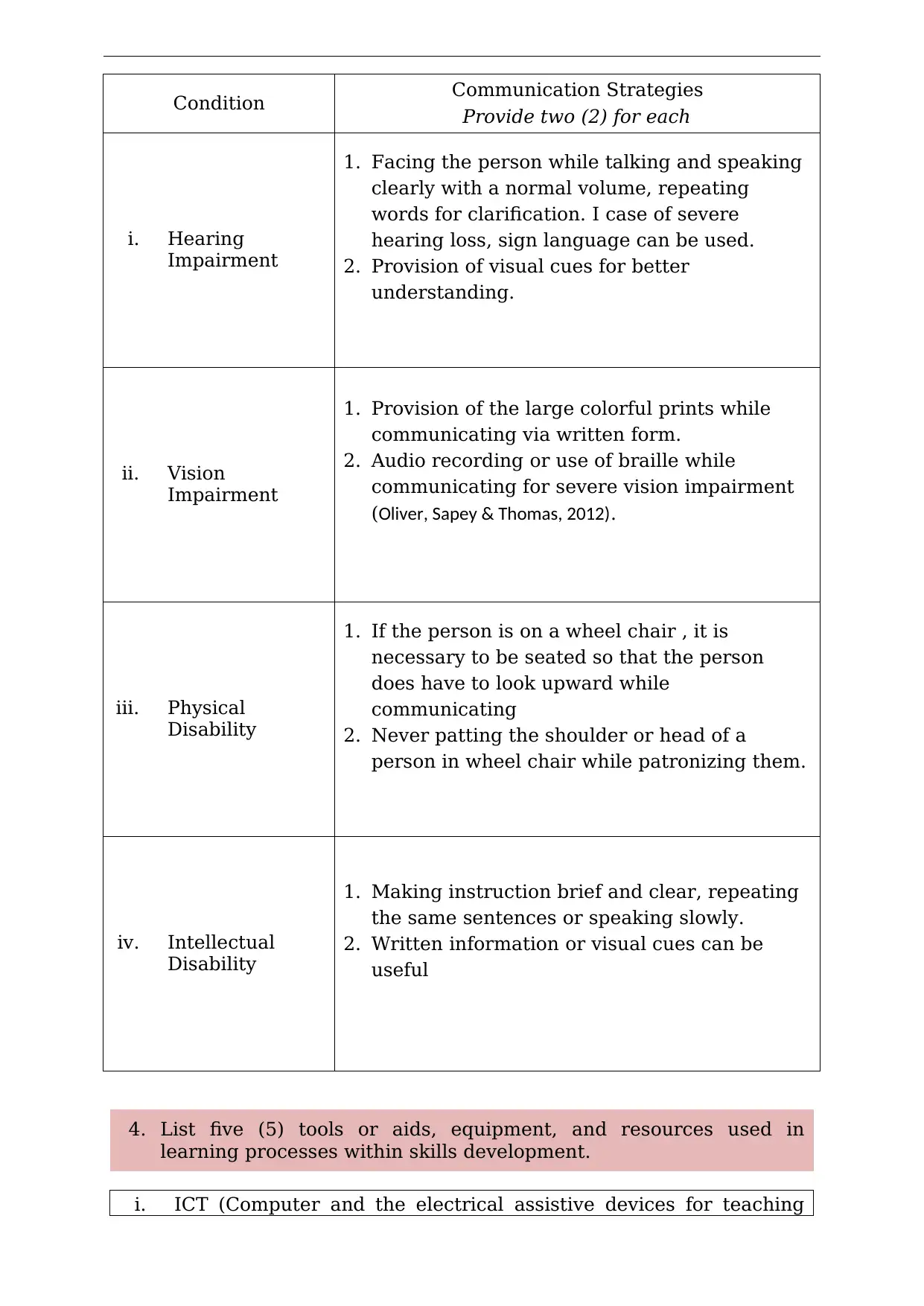
Condition Communication Strategies
Provide two (2) for each
i. Hearing
Impairment
1. Facing the person while talking and speaking
clearly with a normal volume, repeating
words for clarification. I case of severe
hearing loss, sign language can be used.
2. Provision of visual cues for better
understanding.
ii. Vision
Impairment
1. Provision of the large colorful prints while
communicating via written form.
2. Audio recording or use of braille while
communicating for severe vision impairment
(Oliver, Sapey & Thomas, 2012).
iii. Physical
Disability
1. If the person is on a wheel chair , it is
necessary to be seated so that the person
does have to look upward while
communicating
2. Never patting the shoulder or head of a
person in wheel chair while patronizing them.
iv. Intellectual
Disability
1. Making instruction brief and clear, repeating
the same sentences or speaking slowly.
2. Written information or visual cues can be
useful
4. List five (5) tools or aids, equipment, and resources used in
learning processes within skills development.
i. ICT (Computer and the electrical assistive devices for teaching
Provide two (2) for each
i. Hearing
Impairment
1. Facing the person while talking and speaking
clearly with a normal volume, repeating
words for clarification. I case of severe
hearing loss, sign language can be used.
2. Provision of visual cues for better
understanding.
ii. Vision
Impairment
1. Provision of the large colorful prints while
communicating via written form.
2. Audio recording or use of braille while
communicating for severe vision impairment
(Oliver, Sapey & Thomas, 2012).
iii. Physical
Disability
1. If the person is on a wheel chair , it is
necessary to be seated so that the person
does have to look upward while
communicating
2. Never patting the shoulder or head of a
person in wheel chair while patronizing them.
iv. Intellectual
Disability
1. Making instruction brief and clear, repeating
the same sentences or speaking slowly.
2. Written information or visual cues can be
useful
4. List five (5) tools or aids, equipment, and resources used in
learning processes within skills development.
i. ICT (Computer and the electrical assistive devices for teaching
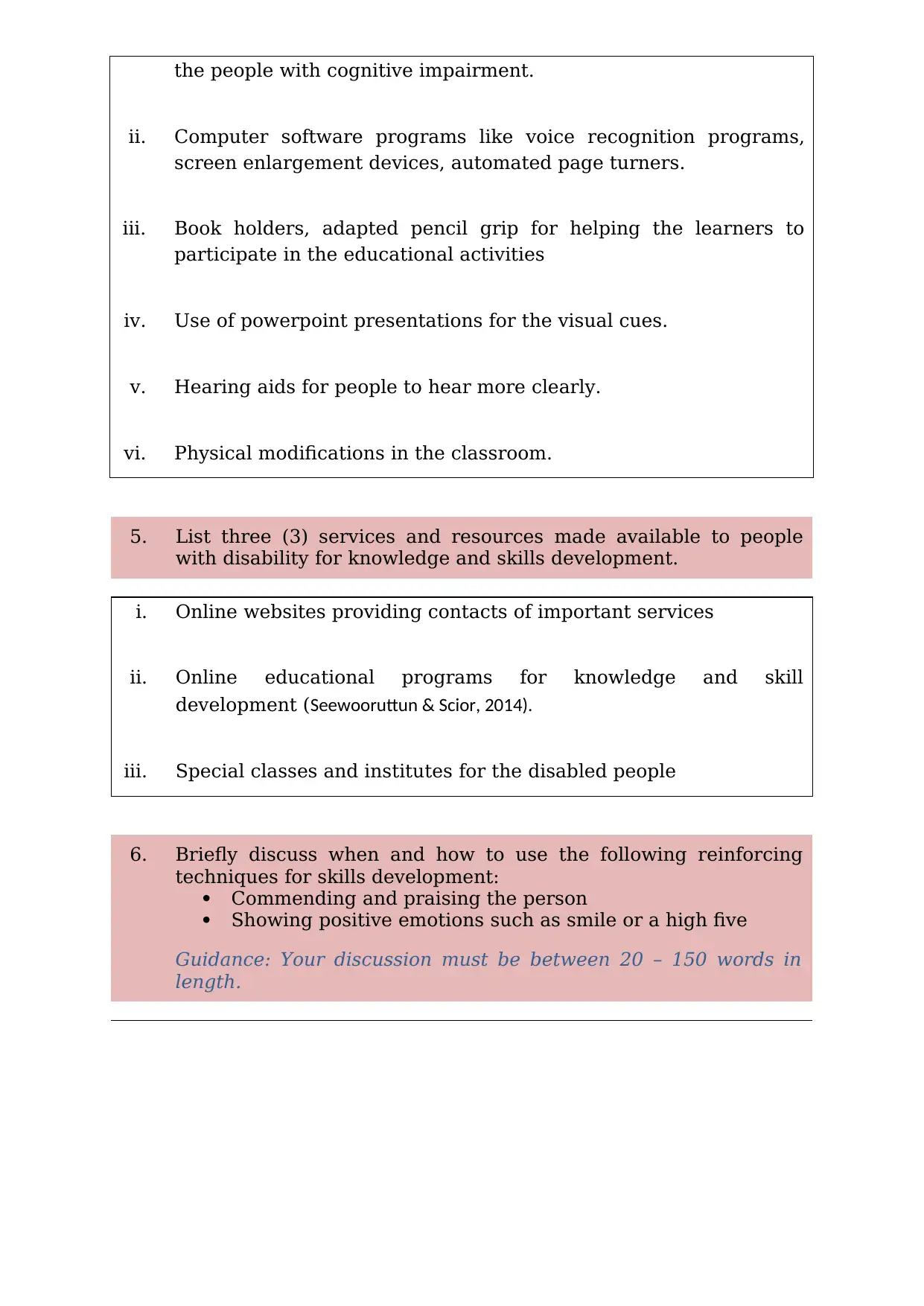
the people with cognitive impairment.
ii. Computer software programs like voice recognition programs,
screen enlargement devices, automated page turners.
iii. Book holders, adapted pencil grip for helping the learners to
participate in the educational activities
iv. Use of powerpoint presentations for the visual cues.
v. Hearing aids for people to hear more clearly.
vi. Physical modifications in the classroom.
5. List three (3) services and resources made available to people
with disability for knowledge and skills development.
i. Online websites providing contacts of important services
ii. Online educational programs for knowledge and skill
development (Seewooruttun & Scior, 2014).
iii. Special classes and institutes for the disabled people
6. Briefly discuss when and how to use the following reinforcing
techniques for skills development:
Commending and praising the person
Showing positive emotions such as smile or a high five
Guidance: Your discussion must be between 20 – 150 words in
length.
ii. Computer software programs like voice recognition programs,
screen enlargement devices, automated page turners.
iii. Book holders, adapted pencil grip for helping the learners to
participate in the educational activities
iv. Use of powerpoint presentations for the visual cues.
v. Hearing aids for people to hear more clearly.
vi. Physical modifications in the classroom.
5. List three (3) services and resources made available to people
with disability for knowledge and skills development.
i. Online websites providing contacts of important services
ii. Online educational programs for knowledge and skill
development (Seewooruttun & Scior, 2014).
iii. Special classes and institutes for the disabled people
6. Briefly discuss when and how to use the following reinforcing
techniques for skills development:
Commending and praising the person
Showing positive emotions such as smile or a high five
Guidance: Your discussion must be between 20 – 150 words in
length.
⊘ This is a preview!⊘
Do you want full access?
Subscribe today to unlock all pages.

Trusted by 1+ million students worldwide
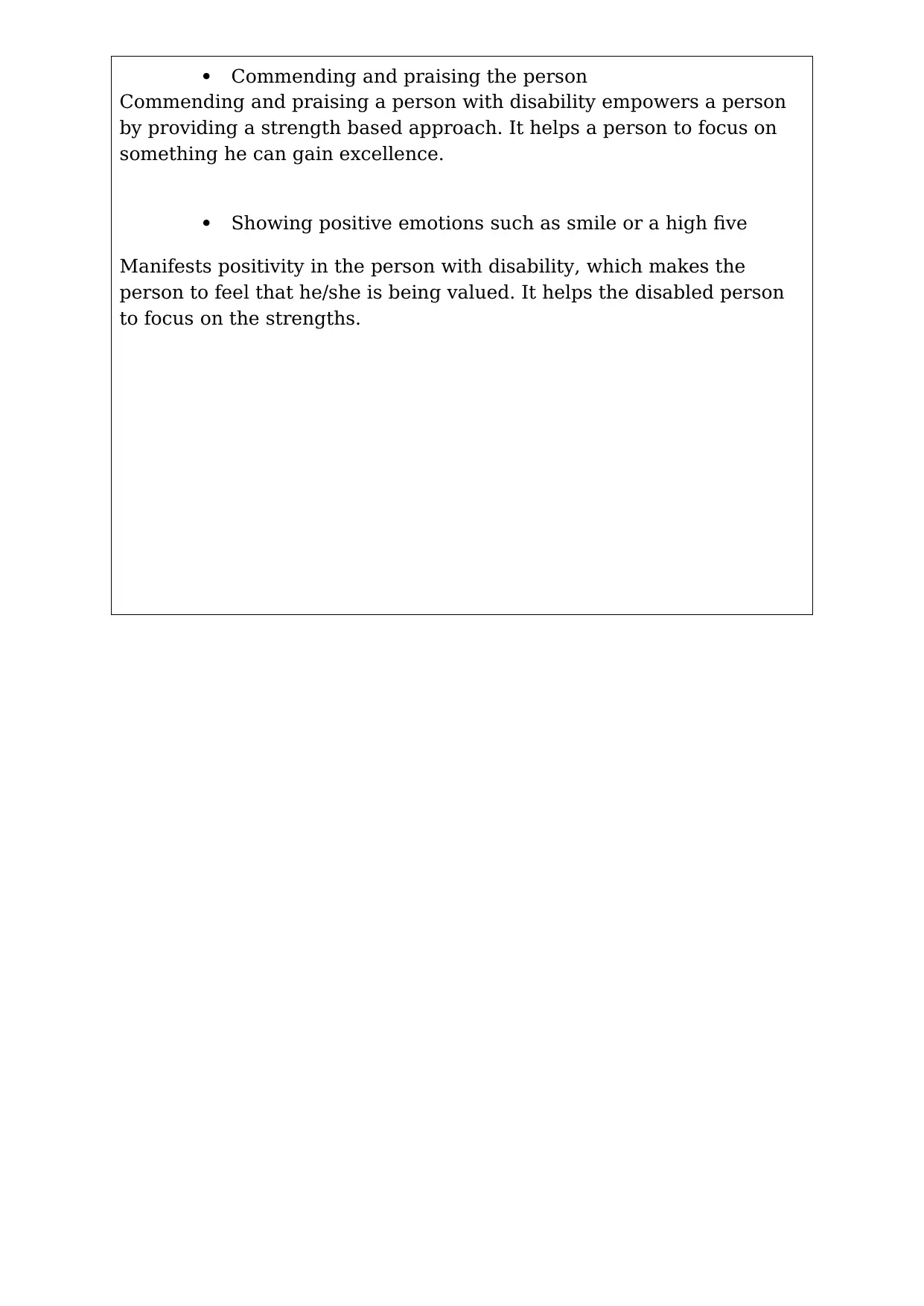
Commending and praising the person
Commending and praising a person with disability empowers a person
by providing a strength based approach. It helps a person to focus on
something he can gain excellence.
Showing positive emotions such as smile or a high five
Manifests positivity in the person with disability, which makes the
person to feel that he/she is being valued. It helps the disabled person
to focus on the strengths.
Commending and praising a person with disability empowers a person
by providing a strength based approach. It helps a person to focus on
something he can gain excellence.
Showing positive emotions such as smile or a high five
Manifests positivity in the person with disability, which makes the
person to feel that he/she is being valued. It helps the disabled person
to focus on the strengths.
Paraphrase This Document
Need a fresh take? Get an instant paraphrase of this document with our AI Paraphraser
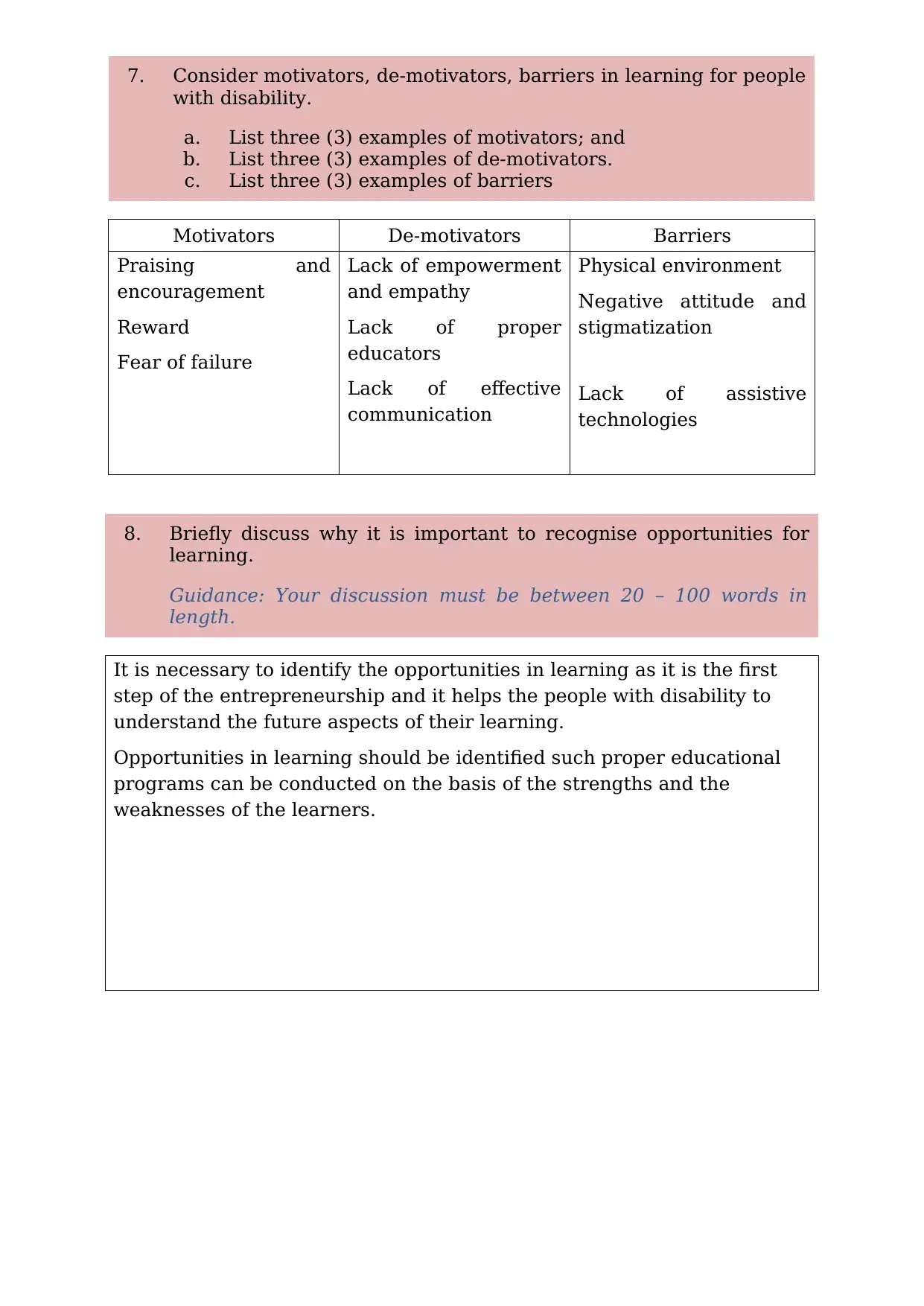
7. Consider motivators, de-motivators, barriers in learning for people
with disability.
a. List three (3) examples of motivators; and
b. List three (3) examples of de-motivators.
c. List three (3) examples of barriers
Motivators De-motivators Barriers
Praising and
encouragement
Reward
Fear of failure
Lack of empowerment
and empathy
Lack of proper
educators
Lack of effective
communication
Physical environment
Negative attitude and
stigmatization
Lack of assistive
technologies
8. Briefly discuss why it is important to recognise opportunities for
learning.
Guidance: Your discussion must be between 20 – 100 words in
length.
It is necessary to identify the opportunities in learning as it is the first
step of the entrepreneurship and it helps the people with disability to
understand the future aspects of their learning.
Opportunities in learning should be identified such proper educational
programs can be conducted on the basis of the strengths and the
weaknesses of the learners.
with disability.
a. List three (3) examples of motivators; and
b. List three (3) examples of de-motivators.
c. List three (3) examples of barriers
Motivators De-motivators Barriers
Praising and
encouragement
Reward
Fear of failure
Lack of empowerment
and empathy
Lack of proper
educators
Lack of effective
communication
Physical environment
Negative attitude and
stigmatization
Lack of assistive
technologies
8. Briefly discuss why it is important to recognise opportunities for
learning.
Guidance: Your discussion must be between 20 – 100 words in
length.
It is necessary to identify the opportunities in learning as it is the first
step of the entrepreneurship and it helps the people with disability to
understand the future aspects of their learning.
Opportunities in learning should be identified such proper educational
programs can be conducted on the basis of the strengths and the
weaknesses of the learners.
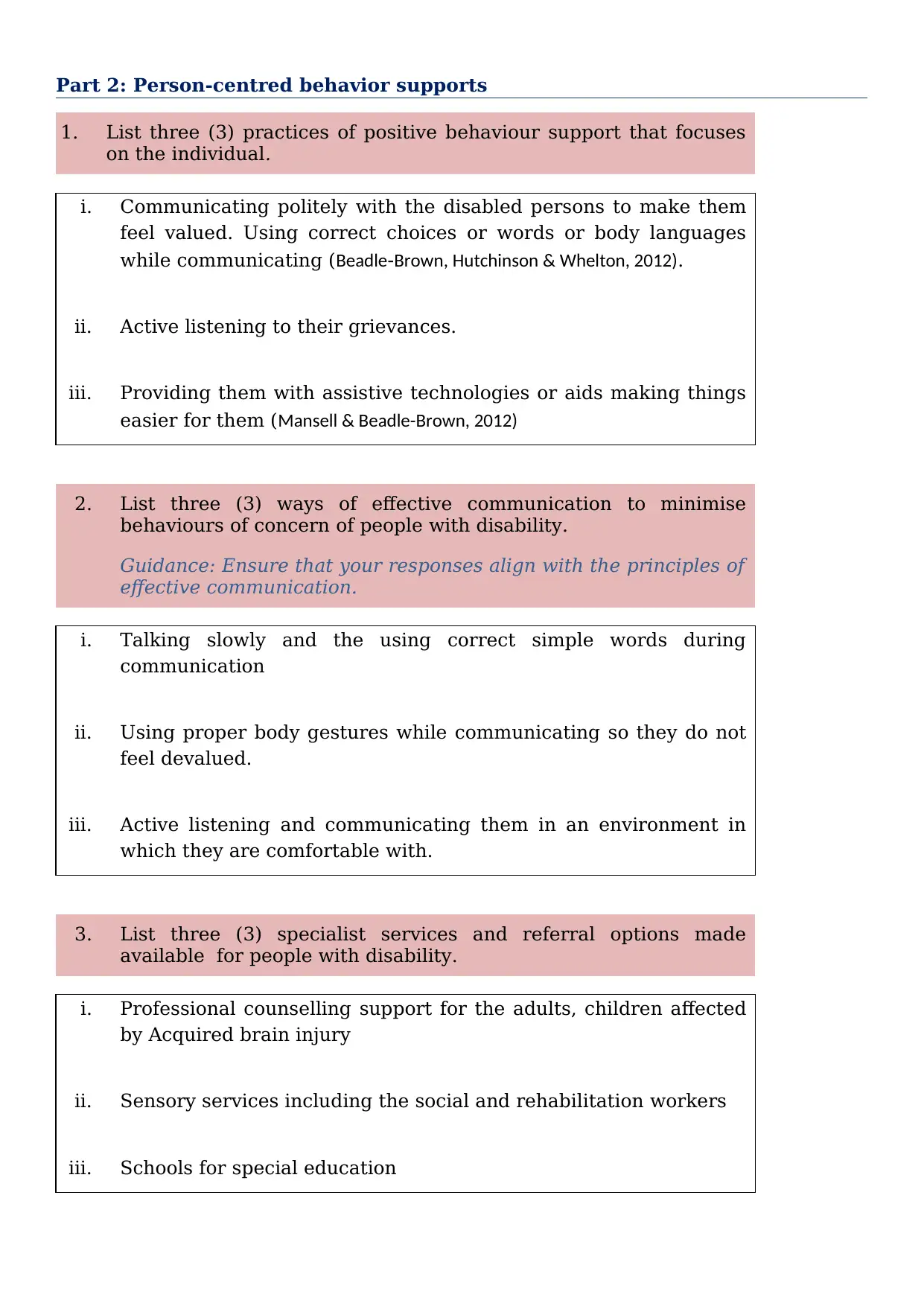
Part 2: Person-centred behavior supports
1. List three (3) practices of positive behaviour support that focuses
on the individual.
i. Communicating politely with the disabled persons to make them
feel valued. Using correct choices or words or body languages
while communicating (Beadle Brown, Hutchinson & Whelton, 2012)‐ .
ii. Active listening to their grievances.
iii. Providing them with assistive technologies or aids making things
easier for them (Mansell & Beadle-Brown, 2012)
2. List three (3) ways of effective communication to minimise
behaviours of concern of people with disability.
Guidance: Ensure that your responses align with the principles of
effective communication.
i. Talking slowly and the using correct simple words during
communication
ii. Using proper body gestures while communicating so they do not
feel devalued.
iii. Active listening and communicating them in an environment in
which they are comfortable with.
3. List three (3) specialist services and referral options made
available for people with disability.
i. Professional counselling support for the adults, children affected
by Acquired brain injury
ii. Sensory services including the social and rehabilitation workers
iii. Schools for special education
1. List three (3) practices of positive behaviour support that focuses
on the individual.
i. Communicating politely with the disabled persons to make them
feel valued. Using correct choices or words or body languages
while communicating (Beadle Brown, Hutchinson & Whelton, 2012)‐ .
ii. Active listening to their grievances.
iii. Providing them with assistive technologies or aids making things
easier for them (Mansell & Beadle-Brown, 2012)
2. List three (3) ways of effective communication to minimise
behaviours of concern of people with disability.
Guidance: Ensure that your responses align with the principles of
effective communication.
i. Talking slowly and the using correct simple words during
communication
ii. Using proper body gestures while communicating so they do not
feel devalued.
iii. Active listening and communicating them in an environment in
which they are comfortable with.
3. List three (3) specialist services and referral options made
available for people with disability.
i. Professional counselling support for the adults, children affected
by Acquired brain injury
ii. Sensory services including the social and rehabilitation workers
iii. Schools for special education
⊘ This is a preview!⊘
Do you want full access?
Subscribe today to unlock all pages.

Trusted by 1+ million students worldwide
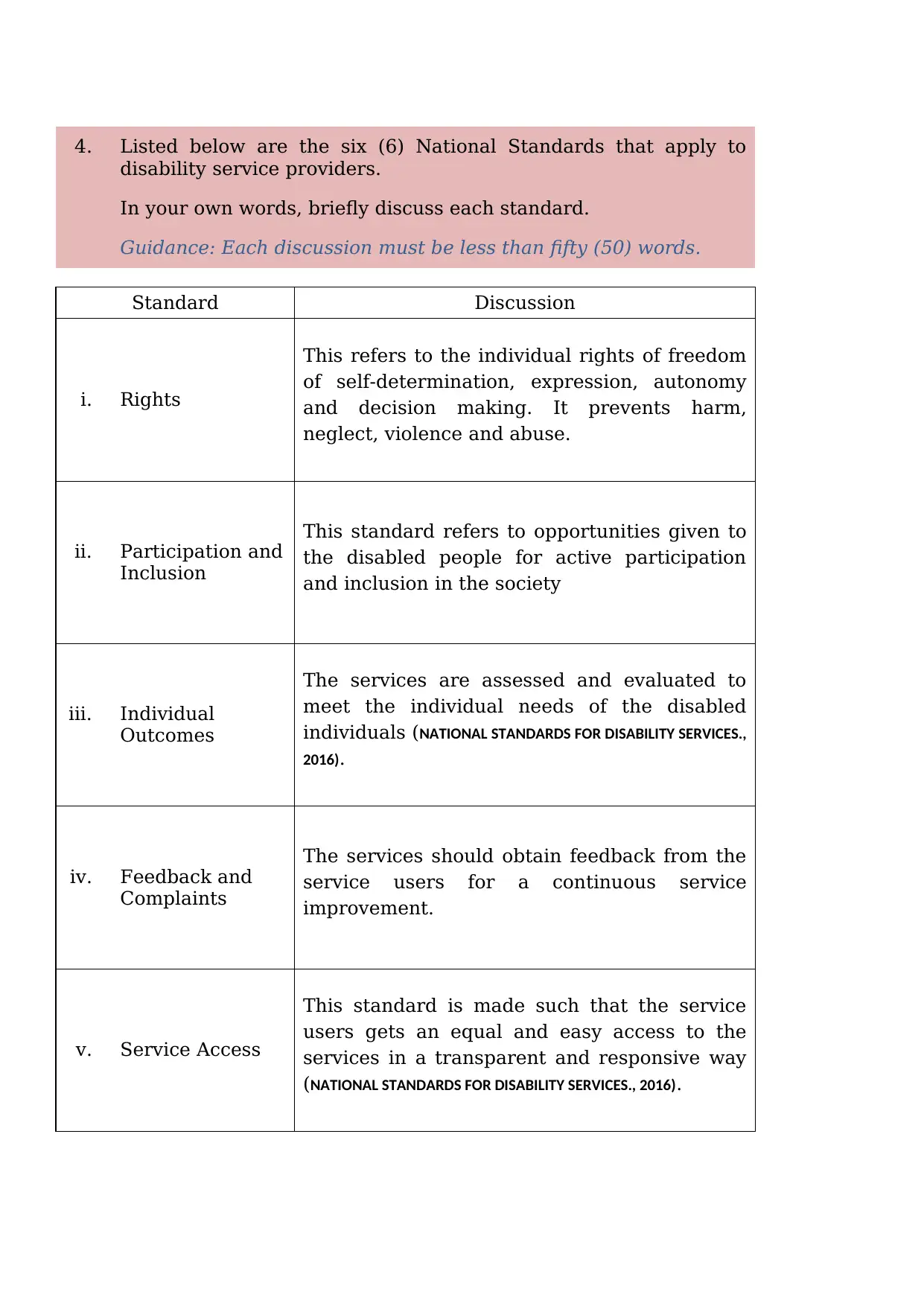
4. Listed below are the six (6) National Standards that apply to
disability service providers.
In your own words, briefly discuss each standard.
Guidance: Each discussion must be less than fifty (50) words.
Standard Discussion
i. Rights
This refers to the individual rights of freedom
of self-determination, expression, autonomy
and decision making. It prevents harm,
neglect, violence and abuse.
ii. Participation and
Inclusion
This standard refers to opportunities given to
the disabled people for active participation
and inclusion in the society
iii. Individual
Outcomes
The services are assessed and evaluated to
meet the individual needs of the disabled
individuals (NATIONAL STANDARDS FOR DISABILITY SERVICES.,
2016).
iv. Feedback and
Complaints
The services should obtain feedback from the
service users for a continuous service
improvement.
v. Service Access
This standard is made such that the service
users gets an equal and easy access to the
services in a transparent and responsive way
(NATIONAL STANDARDS FOR DISABILITY SERVICES., 2016).
disability service providers.
In your own words, briefly discuss each standard.
Guidance: Each discussion must be less than fifty (50) words.
Standard Discussion
i. Rights
This refers to the individual rights of freedom
of self-determination, expression, autonomy
and decision making. It prevents harm,
neglect, violence and abuse.
ii. Participation and
Inclusion
This standard refers to opportunities given to
the disabled people for active participation
and inclusion in the society
iii. Individual
Outcomes
The services are assessed and evaluated to
meet the individual needs of the disabled
individuals (NATIONAL STANDARDS FOR DISABILITY SERVICES.,
2016).
iv. Feedback and
Complaints
The services should obtain feedback from the
service users for a continuous service
improvement.
v. Service Access
This standard is made such that the service
users gets an equal and easy access to the
services in a transparent and responsive way
(NATIONAL STANDARDS FOR DISABILITY SERVICES., 2016).
Paraphrase This Document
Need a fresh take? Get an instant paraphrase of this document with our AI Paraphraser
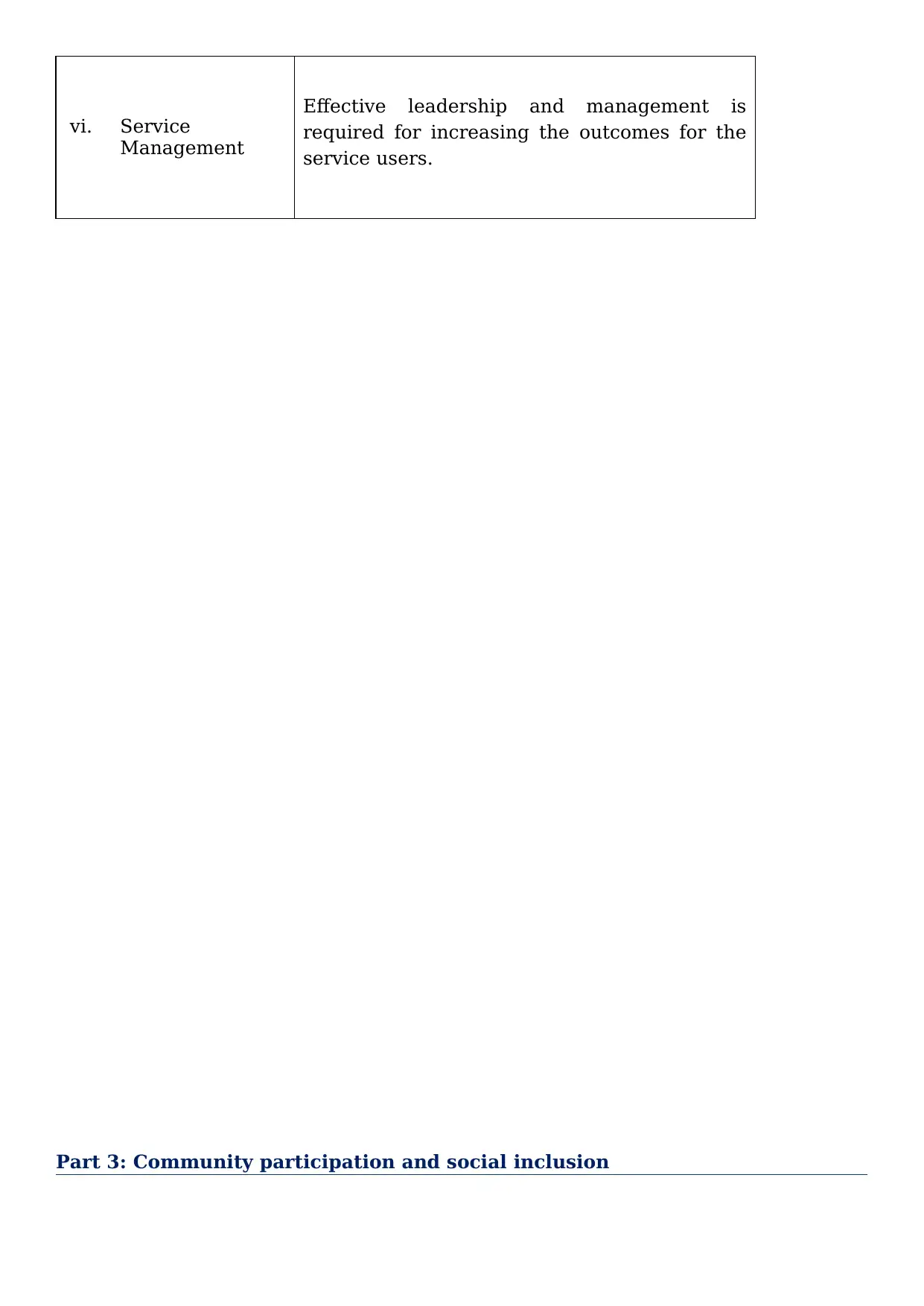
vi. Service
Management
Effective leadership and management is
required for increasing the outcomes for the
service users.
Part 3: Community participation and social inclusion
Management
Effective leadership and management is
required for increasing the outcomes for the
service users.
Part 3: Community participation and social inclusion
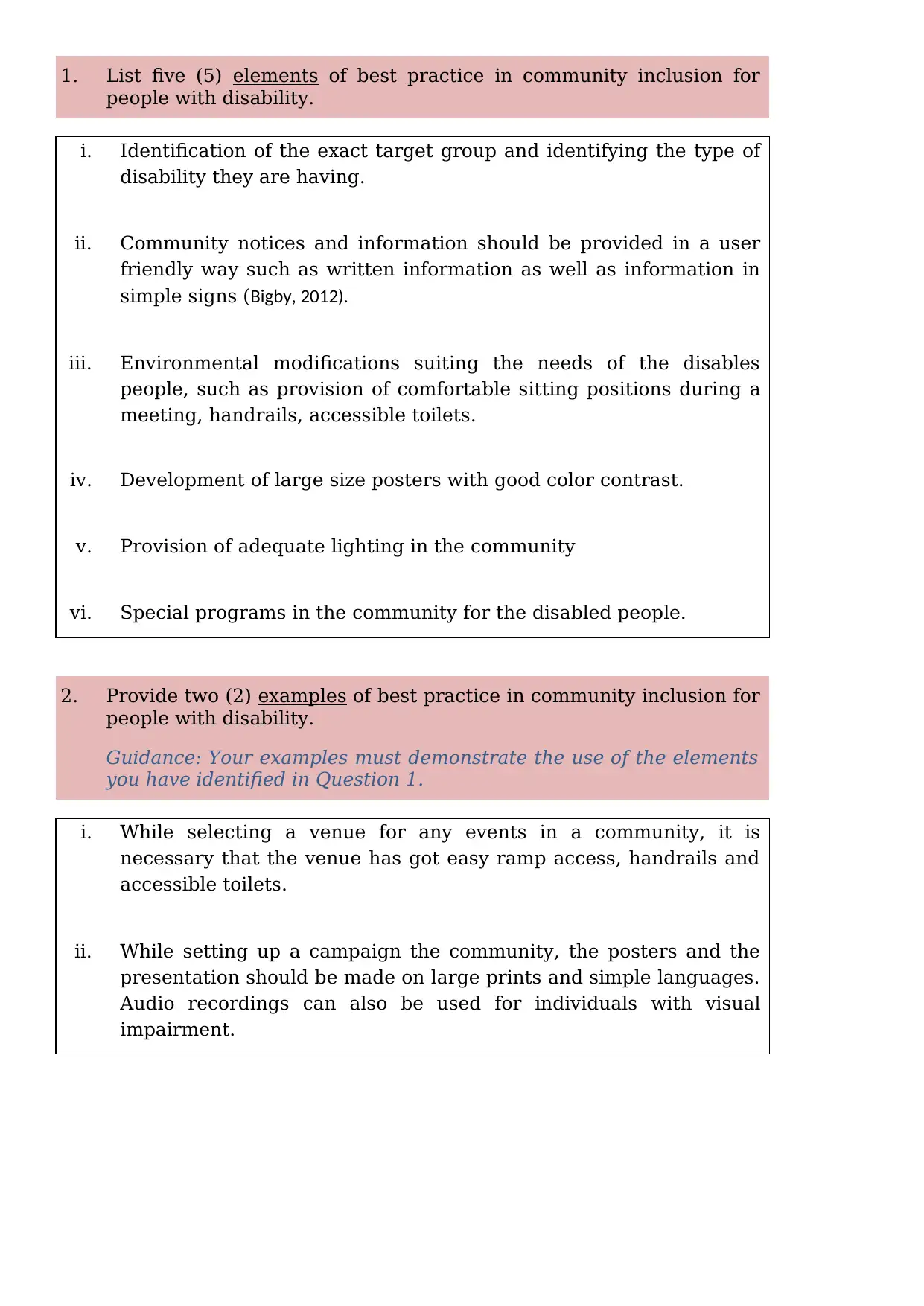
1. List five (5) elements of best practice in community inclusion for
people with disability.
i. Identification of the exact target group and identifying the type of
disability they are having.
ii. Community notices and information should be provided in a user
friendly way such as written information as well as information in
simple signs (Bigby, 2012).
iii. Environmental modifications suiting the needs of the disables
people, such as provision of comfortable sitting positions during a
meeting, handrails, accessible toilets.
iv. Development of large size posters with good color contrast.
v. Provision of adequate lighting in the community
vi. Special programs in the community for the disabled people.
2. Provide two (2) examples of best practice in community inclusion for
people with disability.
Guidance: Your examples must demonstrate the use of the elements
you have identified in Question 1.
i. While selecting a venue for any events in a community, it is
necessary that the venue has got easy ramp access, handrails and
accessible toilets.
ii. While setting up a campaign the community, the posters and the
presentation should be made on large prints and simple languages.
Audio recordings can also be used for individuals with visual
impairment.
people with disability.
i. Identification of the exact target group and identifying the type of
disability they are having.
ii. Community notices and information should be provided in a user
friendly way such as written information as well as information in
simple signs (Bigby, 2012).
iii. Environmental modifications suiting the needs of the disables
people, such as provision of comfortable sitting positions during a
meeting, handrails, accessible toilets.
iv. Development of large size posters with good color contrast.
v. Provision of adequate lighting in the community
vi. Special programs in the community for the disabled people.
2. Provide two (2) examples of best practice in community inclusion for
people with disability.
Guidance: Your examples must demonstrate the use of the elements
you have identified in Question 1.
i. While selecting a venue for any events in a community, it is
necessary that the venue has got easy ramp access, handrails and
accessible toilets.
ii. While setting up a campaign the community, the posters and the
presentation should be made on large prints and simple languages.
Audio recordings can also be used for individuals with visual
impairment.
⊘ This is a preview!⊘
Do you want full access?
Subscribe today to unlock all pages.

Trusted by 1+ million students worldwide
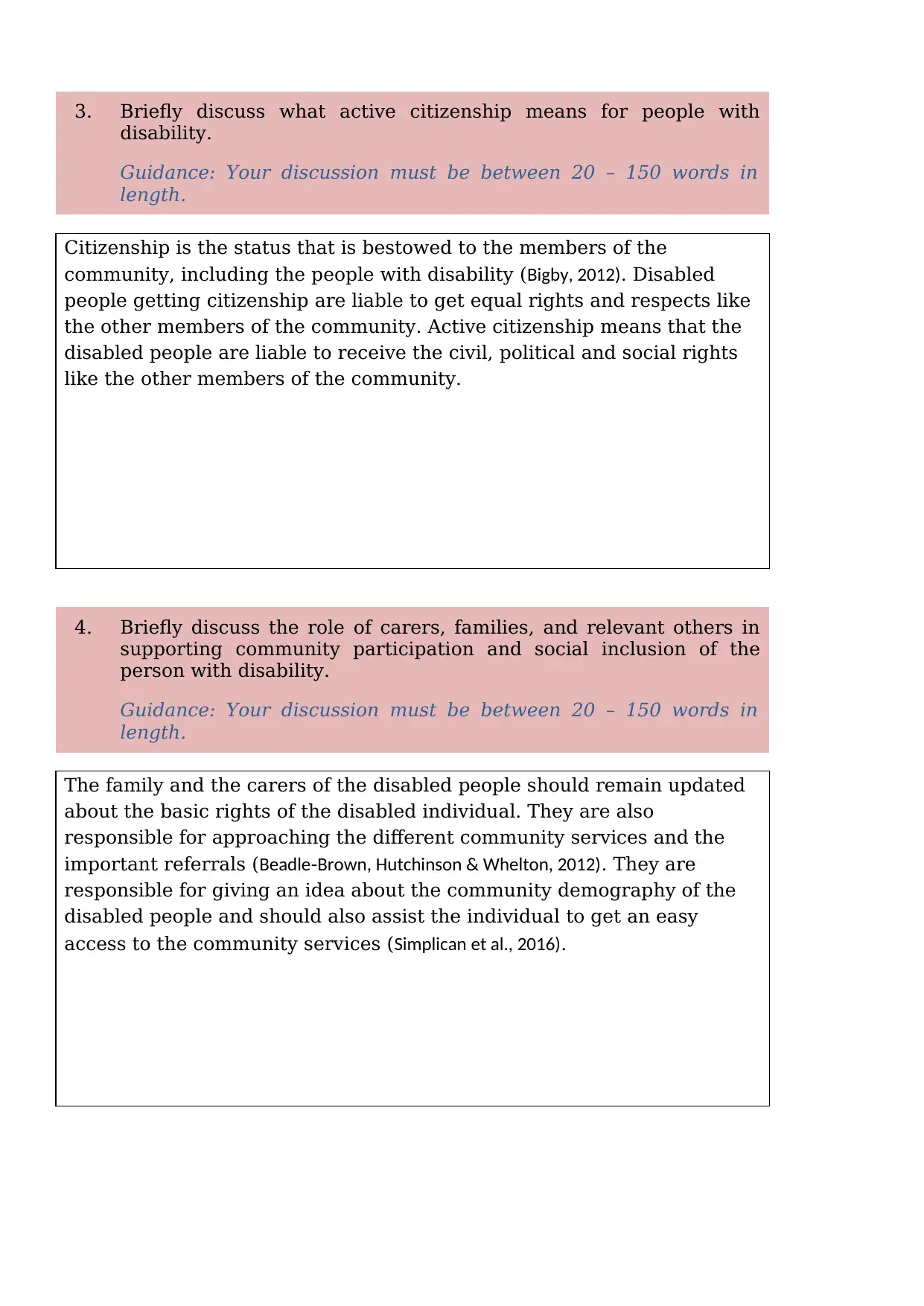
3. Briefly discuss what active citizenship means for people with
disability.
Guidance: Your discussion must be between 20 – 150 words in
length.
Citizenship is the status that is bestowed to the members of the
community, including the people with disability (Bigby, 2012). Disabled
people getting citizenship are liable to get equal rights and respects like
the other members of the community. Active citizenship means that the
disabled people are liable to receive the civil, political and social rights
like the other members of the community.
4. Briefly discuss the role of carers, families, and relevant others in
supporting community participation and social inclusion of the
person with disability.
Guidance: Your discussion must be between 20 – 150 words in
length.
The family and the carers of the disabled people should remain updated
about the basic rights of the disabled individual. They are also
responsible for approaching the different community services and the
important referrals (Beadle Brown, Hutchinson & Whelton, 2012)‐ . They are
responsible for giving an idea about the community demography of the
disabled people and should also assist the individual to get an easy
access to the community services (Simplican et al., 2016).
disability.
Guidance: Your discussion must be between 20 – 150 words in
length.
Citizenship is the status that is bestowed to the members of the
community, including the people with disability (Bigby, 2012). Disabled
people getting citizenship are liable to get equal rights and respects like
the other members of the community. Active citizenship means that the
disabled people are liable to receive the civil, political and social rights
like the other members of the community.
4. Briefly discuss the role of carers, families, and relevant others in
supporting community participation and social inclusion of the
person with disability.
Guidance: Your discussion must be between 20 – 150 words in
length.
The family and the carers of the disabled people should remain updated
about the basic rights of the disabled individual. They are also
responsible for approaching the different community services and the
important referrals (Beadle Brown, Hutchinson & Whelton, 2012)‐ . They are
responsible for giving an idea about the community demography of the
disabled people and should also assist the individual to get an easy
access to the community services (Simplican et al., 2016).
Paraphrase This Document
Need a fresh take? Get an instant paraphrase of this document with our AI Paraphraser
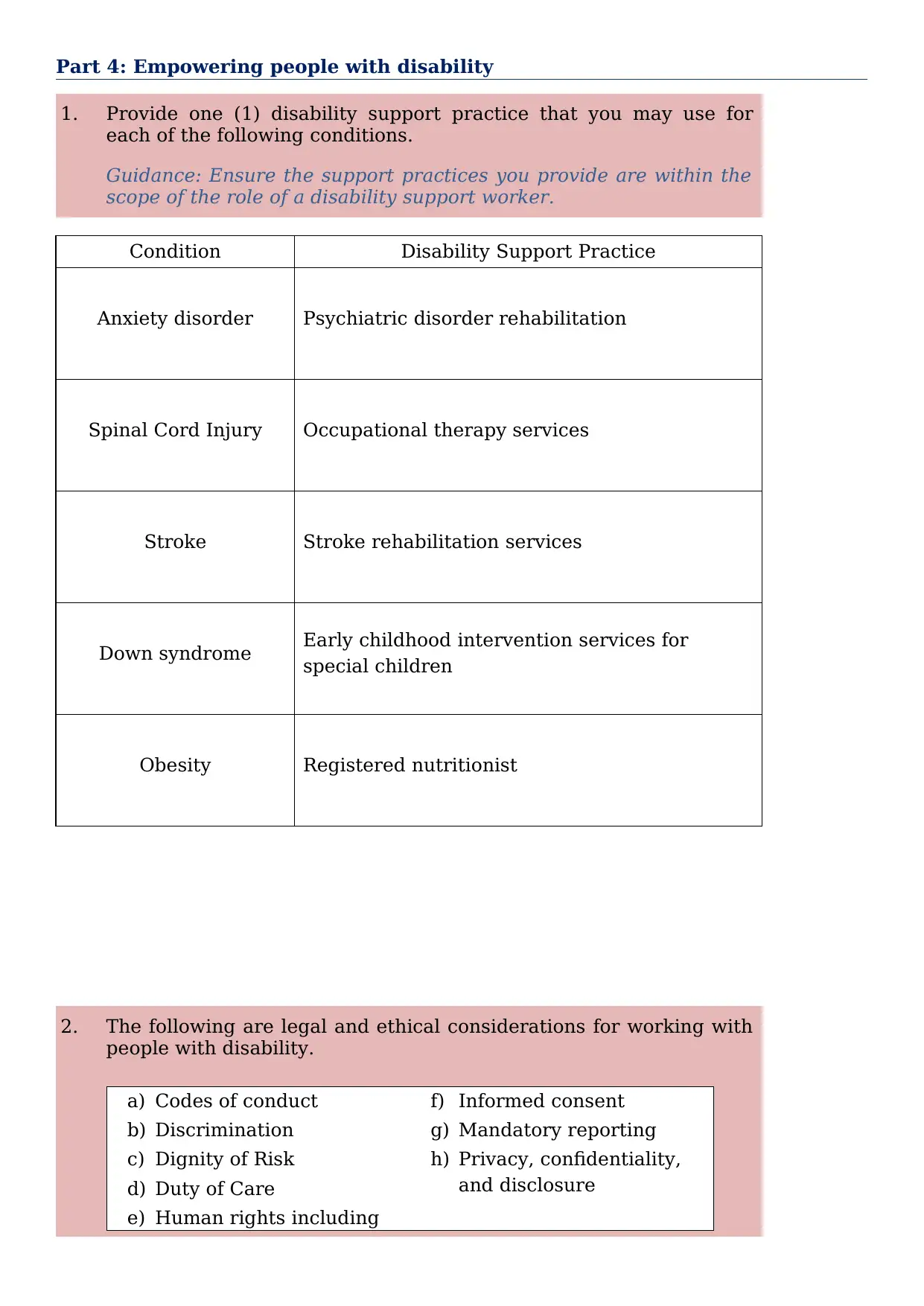
Part 4: Empowering people with disability
1. Provide one (1) disability support practice that you may use for
each of the following conditions.
Guidance: Ensure the support practices you provide are within the
scope of the role of a disability support worker.
Condition Disability Support Practice
Anxiety disorder Psychiatric disorder rehabilitation
Spinal Cord Injury Occupational therapy services
Stroke Stroke rehabilitation services
Down syndrome Early childhood intervention services for
special children
Obesity Registered nutritionist
2. The following are legal and ethical considerations for working with
people with disability.
a) Codes of conduct
b) Discrimination
c) Dignity of Risk
d) Duty of Care
e) Human rights including
f) Informed consent
g) Mandatory reporting
h) Privacy, confidentiality,
and disclosure
1. Provide one (1) disability support practice that you may use for
each of the following conditions.
Guidance: Ensure the support practices you provide are within the
scope of the role of a disability support worker.
Condition Disability Support Practice
Anxiety disorder Psychiatric disorder rehabilitation
Spinal Cord Injury Occupational therapy services
Stroke Stroke rehabilitation services
Down syndrome Early childhood intervention services for
special children
Obesity Registered nutritionist
2. The following are legal and ethical considerations for working with
people with disability.
a) Codes of conduct
b) Discrimination
c) Dignity of Risk
d) Duty of Care
e) Human rights including
f) Informed consent
g) Mandatory reporting
h) Privacy, confidentiality,
and disclosure
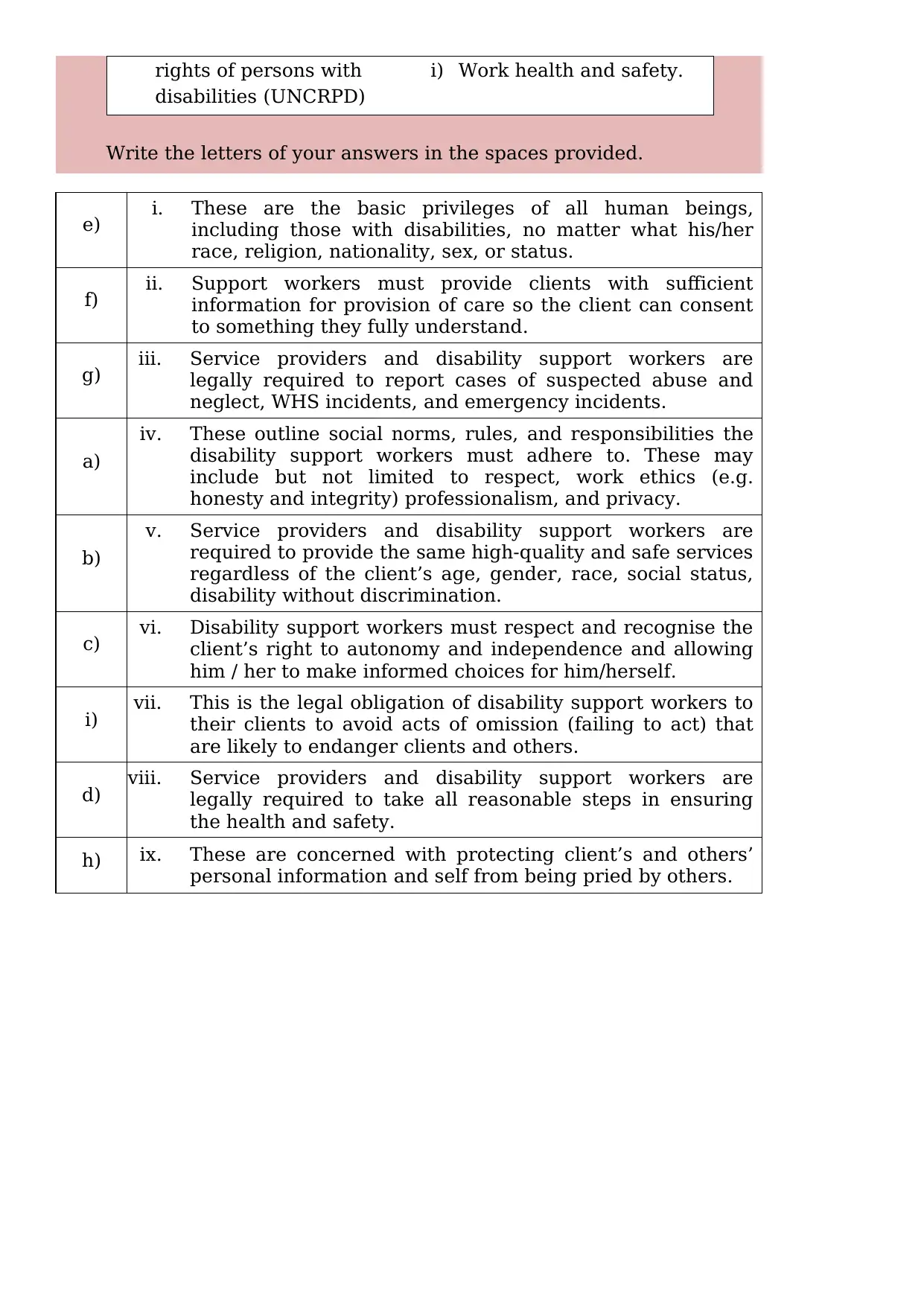
rights of persons with
disabilities (UNCRPD)
i) Work health and safety.
Write the letters of your answers in the spaces provided.
e) i. These are the basic privileges of all human beings,
including those with disabilities, no matter what his/her
race, religion, nationality, sex, or status.
f) ii. Support workers must provide clients with sufficient
information for provision of care so the client can consent
to something they fully understand.
g) iii. Service providers and disability support workers are
legally required to report cases of suspected abuse and
neglect, WHS incidents, and emergency incidents.
a)
iv. These outline social norms, rules, and responsibilities the
disability support workers must adhere to. These may
include but not limited to respect, work ethics (e.g.
honesty and integrity) professionalism, and privacy.
b)
v. Service providers and disability support workers are
required to provide the same high-quality and safe services
regardless of the client’s age, gender, race, social status,
disability without discrimination.
c) vi. Disability support workers must respect and recognise the
client’s right to autonomy and independence and allowing
him / her to make informed choices for him/herself.
i) vii. This is the legal obligation of disability support workers to
their clients to avoid acts of omission (failing to act) that
are likely to endanger clients and others.
d) viii. Service providers and disability support workers are
legally required to take all reasonable steps in ensuring
the health and safety.
h) ix. These are concerned with protecting client’s and others’
personal information and self from being pried by others.
disabilities (UNCRPD)
i) Work health and safety.
Write the letters of your answers in the spaces provided.
e) i. These are the basic privileges of all human beings,
including those with disabilities, no matter what his/her
race, religion, nationality, sex, or status.
f) ii. Support workers must provide clients with sufficient
information for provision of care so the client can consent
to something they fully understand.
g) iii. Service providers and disability support workers are
legally required to report cases of suspected abuse and
neglect, WHS incidents, and emergency incidents.
a)
iv. These outline social norms, rules, and responsibilities the
disability support workers must adhere to. These may
include but not limited to respect, work ethics (e.g.
honesty and integrity) professionalism, and privacy.
b)
v. Service providers and disability support workers are
required to provide the same high-quality and safe services
regardless of the client’s age, gender, race, social status,
disability without discrimination.
c) vi. Disability support workers must respect and recognise the
client’s right to autonomy and independence and allowing
him / her to make informed choices for him/herself.
i) vii. This is the legal obligation of disability support workers to
their clients to avoid acts of omission (failing to act) that
are likely to endanger clients and others.
d) viii. Service providers and disability support workers are
legally required to take all reasonable steps in ensuring
the health and safety.
h) ix. These are concerned with protecting client’s and others’
personal information and self from being pried by others.
⊘ This is a preview!⊘
Do you want full access?
Subscribe today to unlock all pages.

Trusted by 1+ million students worldwide
1 out of 21
Your All-in-One AI-Powered Toolkit for Academic Success.
+13062052269
info@desklib.com
Available 24*7 on WhatsApp / Email
![[object Object]](/_next/static/media/star-bottom.7253800d.svg)
Unlock your academic potential
Copyright © 2020–2025 A2Z Services. All Rights Reserved. Developed and managed by ZUCOL.


